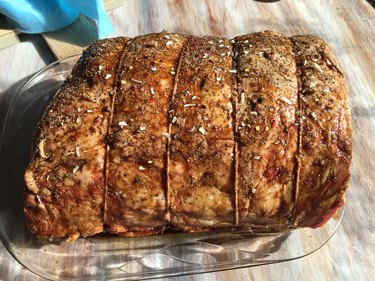
Microwave, cold water and refrigerator thawing are the three safe ways to thaw a rib-eye roast. Microwave thawing is different, however, in that you must cook the meat as soon as it thaws. This is because microwave thawing does not occur evenly and chances are good that the outside of your roast will start to cook while the inside is still thawing. Immediate cooking is then necessary to destroy bacteria that thawing temperatures cannot kill. Thawing a rib-eye roast in a microwave is the quickest thawing method, but it requires your attention during every step of the process.
Step 1
Remove the rib-eye roast from your freezer and read the weight label. Multiply the weight of your roast first by six and then by eight to get the range of how long it will take for your roast to thaw. Most rib-eye roasts are 3 to 8 lbs., so for example, if your roast is 4 lbs., it will take 24 to 32 minutes to thaw.
Video of the Day
Step 2
Transfer the rib-eye roast from its original packaging to a microwave-safe dish. Run cold water over the roast to loosen the plastic wrapping or foam tray if it sticks to the roast.
Step 3
Set the roast in your microwave and close the door. If your microwave has a custom control for thawing, set it to "Beef" and enter the weight of your roast. If your microwave does not have such a control, set the power level to "Low" and start your microwave.
Step 4
Turn the rib-eye roast and/or rotate the baking dish according to the instructions your microwave gives if you have a custom control. If you are thawing the rib eye manually, set a kitchen timer for about four minutes, then turn the roast and rotate the baking dish. Reset the timer and continue the process until the thawing time is complete.
Step 5
Don oven mitts, remove the rib-eye roast from your microwave and cook it immediately.
Things You'll Need
Microwave-safe dish
Kitchen timer
Spatula
Tongs
Oven mitts
Tip
Turn the rib-eye roast as necessary using tongs or a spatula to avoid piercing the meat and losing juices when it cooks. If you need to use your hands, wash them in hot, soapy water before and after touching the raw meat.
Although you may have to lengthen the cooking time, it is safe to cook a rib-eye roast that is still frozen. You can stop thawing at any time and immediately start cooking the roast using any method except a slow cooker. Adjust the cooking time as necessary and use a meat thermometer to check for doneness.
Video of the Day